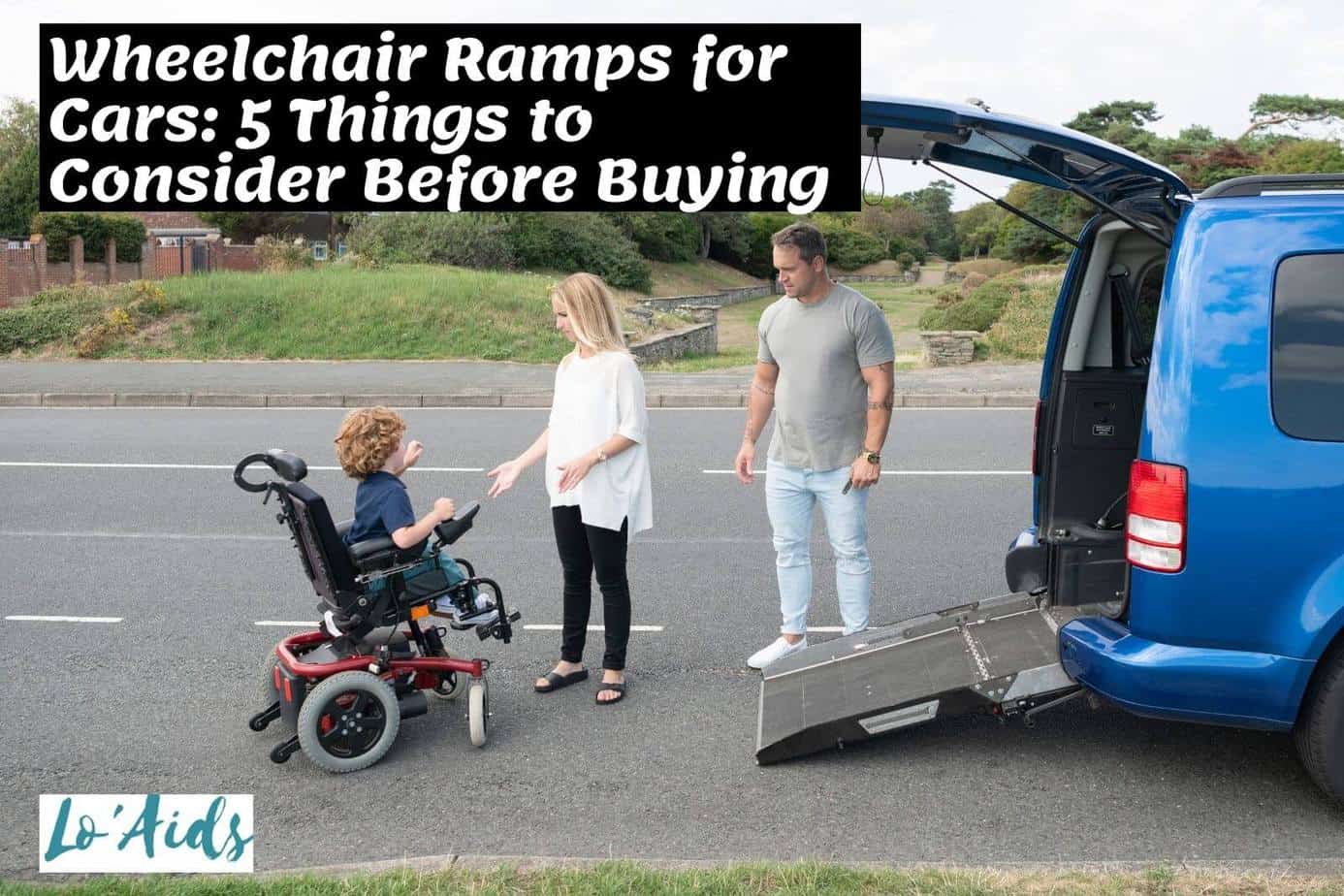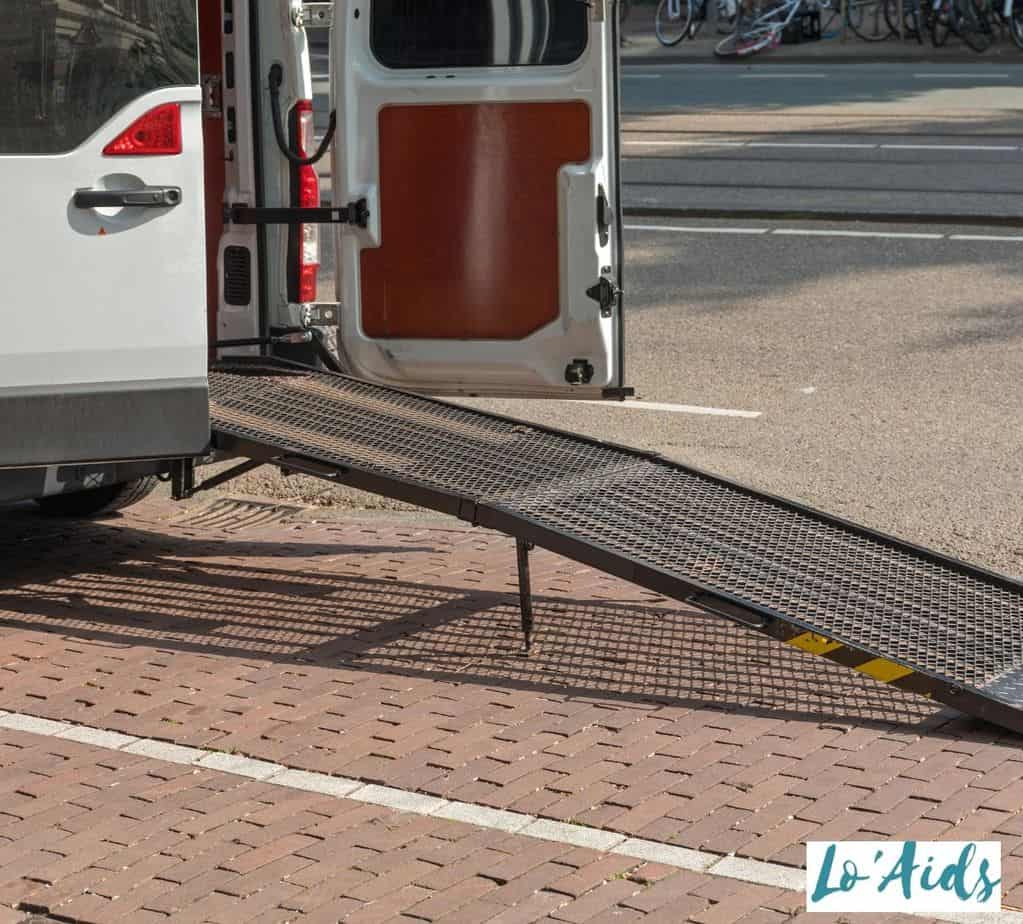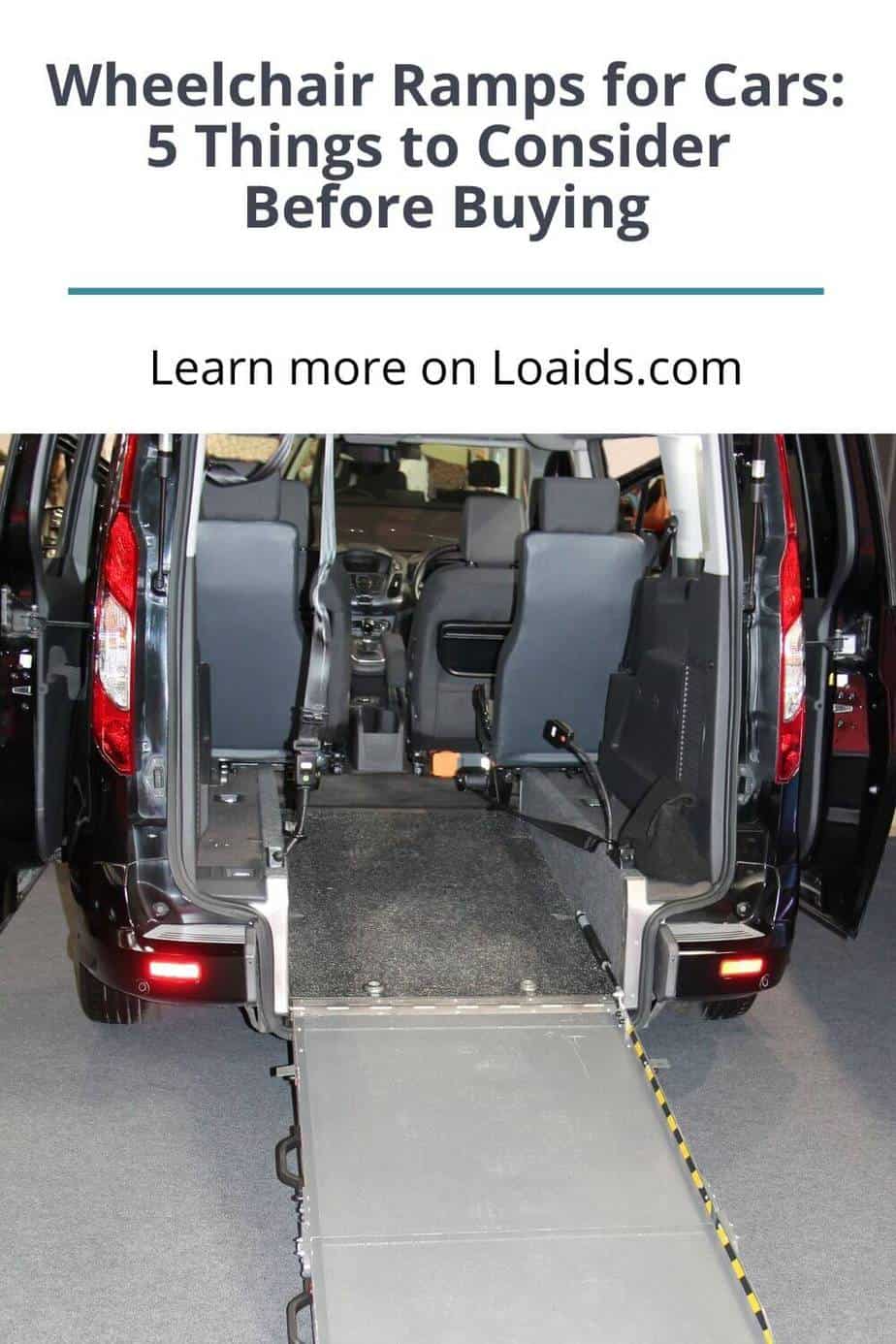Are you thinking about getting a wheelchair ramp for your car and can’t make your mind?
As you’ll find out later, there are different types of wheelchair ramps, and not all of them are suitable for cars.
Fortunately, we’re here to discuss your options and help you choose the best one for you.
Just keep reading!
Table of Contents
Wheelchair Ramps for Cars: 5 Things to Consider Before Buying
Good wheelchair ramps for vehicles ensure that you get in and out of your car safely and with minimum effort.

Moreover, portable ramps come in handy when you’re traveling in a wheelchair and have to deal with uneven surfaces or non-wheelchair accessible buildings.
But it’s easy to get confused and overwhelmed by the many buying options on Amazon, 1800wheelchair, and other sites.
That’s why we’re here with five questions to consider before buying one of these portable ramps.
#1 What Are the Most Popular Types of Wheelchair Ramps?
A study, published in the Journal of Rehabilitation & Research on portable ramps states, “No single ramp design met the needs of all the wheelchair users or caregivers.”
As such, it’s not surprising that wheelchair ramps come in a wide variety of designs and styles to meet the individual needs of as many wheelchair users as possible. More about it in a bit.
So, when you’re buying a wheelchair car ramp, you need it to be portable, easy to use, and not take much space in your vehicle.
Let’s take a look at the most popular types of ramps to determine which ones are suitable for cars.
Suitcase Ramps
Suitcase ramps are excellent for stairs and vehicles because of their single-fold design, portability, and weight.
While suitcase ramps are best suited for low to moderate rises, they’ve got many of the benefits of permanent wheelchair ramps and have an excellent weight capacity (800 lbs capacity).
The best is that you can split the ramp into two parts and carry the pieces by the built-in carrying handles whenever you have to travel.
So, if you’re looking for lightweight wheelchair ramps for cars, this design should do great a great job.
Check this video to learn more:
Multifold Ramps
Similar to suitcase ramps, folding ones are versatile, portable, and easy to use. They’re suitable for outdoor use and scooters, power wheelchairs, and other walking aids for elderly.
Aluminum multi-fold wheelchair ramps also have a great weight capacity, and some models come with a built-in handle for easy transportation.
As such, multifold ramps are an excellent choice for cars when you’re looking for something wider and easy to store.
Foldout/In-floor Ramps
Accessible vehicles usually feature foldout ramps or in-floor ramps. Foldout ramps stay upright alongside the closed doors when not in use, while in-floor ones retract into the floor.
So, what that this means for you?
In general, in-floors are better than fold-out ramps if you’re thinking about getting one installed in your car. That’s because they aren’t in the way of an able-bodied passenger when they have to leave the vehicle.
The good thing about foldout ramps and in-floor ones is that you can have them customized to fit your vehicle and they don’t take as much space as other portable ramps.
But you can’t use these ramps outside your vehicle. Check the video below.
Threshold Ramps
Composed of rubber or metal, threshold ramps are designed to sit flush against thresholds. They allow wheelchair users, mobility scooters, and walkers to overcome uneven surfaces.
In general, threshold ramps are light and easy to install. But they’ve got a lower maximum weight capacity than other types, and not all are suitable for cars/vans.
Still, some portable threshold ramps might be a good option for an accessible vehicle.
Telescopic Ramps
Telescopic ramps consist of two narrow channels that line up with the wheelchair’s wheels and have 600 pounds and more weight capacity. You can retract or extend the ramp until it reaches the desired length.
As such, telescoping ramps are an excellent choice for vans and other non-wheelchair-accessible vehicles.
But they don’t always work very well with all portable wheelchair scooter models, and their capacity is lower than other models.
Permanent and Modular Wheelchair Ramps
Permanent ramps and modular ones are best suited for home use. The difference between the two is that permanent ones can’t be removed as easily as modular ones.
While modular ramps can be taken apart and assembled again, they aren’t suitable for cars so much as portable wheelchair car ramps.
Remember that, unlike permanent ones, most lightweight wheelchair ramps for cars don’t have rails, and you’ll need a caregiver to help you ascend it safely.
#2 What is the Best Material for a Wheelchair Ramp?
No matter what wheelchair car ramp design you choose, its durability and sturdiness are of the utmost importance. Can you guess why?
A portable ramp for wheelchairs or power chairs is going to be exposed to the elements. The wrong material will wear down in a couple of months, and you’ll have to get a replacement.

So, what’s the best material to choose for wheelchair ramps for cars?
In general, these ramps are made of aluminum, wood, steel, and concrete. From all these materials, aluminum is the best choice for temporal and permanent use.
That’s because aluminum ramps have great weight capacity without being too heavy to lift and transport. Moreover, an aluminum ramp is affordable to build/install, easy to maintain, and weather-resistant
On the other hand, steel ramps are prone to rust, while wood ones are likely to rot, warp, and crack without proper maintenance. That’s why most portable wheelchair ramps are made of aluminum.
Still, some portable ramps are also made out of carbon, which is lighter and more durable than aluminum. However, carbon wheelchair car ramps are expensive and difficult to find.
CHECK: How Long Does a Ramp Need to Be?
#3 How Long Should My Portable Ramp Be?
The next thing to consider when you’re buying a portable folding ramp is length. You don’t want to end up with a ramp for cars that’s too short or too long because it will be difficult to navigate.
ADA’s rule of thumb states that commercial ramps should have a maximum slope of 1:12. That means one foot of length for every inch of rise to ensure that the ramp is safe and not too steep.
However, this recommendation applies to commercial ramps for buildings. No one is going to come and sanction you if you get a shorter one.
As Jonh Burfield from LifewayMobility points out, “a slope ratio of 2:12 is also acceptable for residential ramps.”
All you have to do is measure the vertical rise from the top step to the ground. Then you divide it by two to get the necessary length. For example, a 24″ rise requires a 12-foot long ramp at minimum.
If no one rides in the wheelchair, experts recommend a 3:12 slope. So, a 24″ rise will require an 8-foot long ramp.
#4 What Features Should You Look In Wheelchair Car Ramps?
Besides type, material, and length, you should consider a couple of other features to ensure that you get the best wheelchair ramp for your vehicle.
Weight Capacity
Look at the maximum weight capacity of your chosen model. Consider your manual/electric wheelchair’s weight and yours to ensure that the ramp can withstand your combined weight.
Non-Slip Surface
Likely, you’ll have to use a wheelchair ramp in snowy or rainy conditions, which can make it very slippery. As such, you need a ramp with an anti-slip tread to ensure that you don’t fall.
Easy to Carry
A portable ramp shouldn’t weigh a ton and be hard to lift. You want something that folds and has a built-in handle for transportation.
The ramp shouldn’t also take much space in the car, or there won’t be any space left for a passenger.
#5 Will Medicare Pay for a Portable Wheelchair Ramp?
Medicare covers durable medical equipment, such as manual/power wheelchairs, portable oxygen equipment, and scooters.
But what about wheelchair scooter ramps or vehicle ramps?

To be eligible for Medicare, experts say the equipment should be “considered directly medically necessary.“
As such, Medicare rarely covers equipment that you use mainly outside your home or items meant for comfort and convenience. Think bath aids, home improvements, and so on.
Portable wheelchair ramps, threshold ramps, and other mobility ramps fall into this category since their purpose is to make life easy for wheelchair users but aren’t medically necessary.
If a physician prescribes you a wheelchair ramp as directly medically necessary, you might be eligible for Medicare. But that happens very rarely.
The good news is that most wheelchair ramps are affordable, with portable threshold ramps being the cheapest on average.
But wait – there’s more.
Several organizations can help if a wheelchair car ramp is outside your budget. You can check the Habitat for Humanity, the United Way, and the National Council on Independent Living, among a few.
Conclusion
Portable wheelchair ramps for cars are an excellent solution for getting in and out of vehicles when traveling and enhancing your mobility outside the house.
A wheelchair ramp for vehicles can also minimize the risk of tripping over thresholds and obstacles. It’s a great alternative to buying wheelchair-accessible vans or wheelchair carriers.
Just make sure that you measure the correct vertical rise to ensure a safe slope and that you select the right type of ramp for your vehicle.

What do you think about these 5 things to consider when buying wheelchair ramps for cars? Would you like to add anything to the list? Tell us in the comment section.




